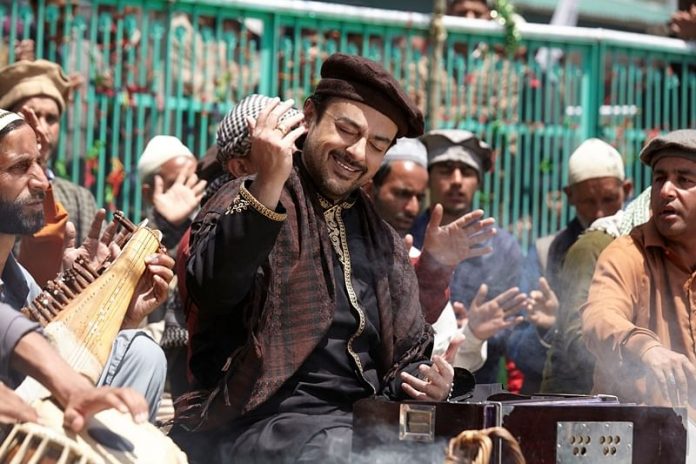“All over South Asia there is Qawwali, for all over South Asia there are Muslims; where there are Muslims; there are Sufis; and where there are Sufis, there is Qawwali – not the popular version of Qawwali adapted for entertainment in clubs and on the screen, but the authentic spiritual song that transports the mystic towards union with God” (Aftab Ahmed). I have heard the Qawwalis used in Bollywood and quite honestly I liked them, it’s true that they are meant for entertainment but they do differ from other Bollywood songs in the way they are sung.
Qawwali in its authentic self
The ‘original’ Qawwali, affects the listeners through a combination of poetry and music, which is the heart of this musical form, the genre of mystical music performed in the ritual assemblies (maḥfil-i samāʿ) of the Chishti Sufi order that thrives in South Asia. Mastering a wide range of poems is essential to a skilled qawwal and it is likewise important in the transmission of musical knowledge among them. (Mikko Viitamäki)
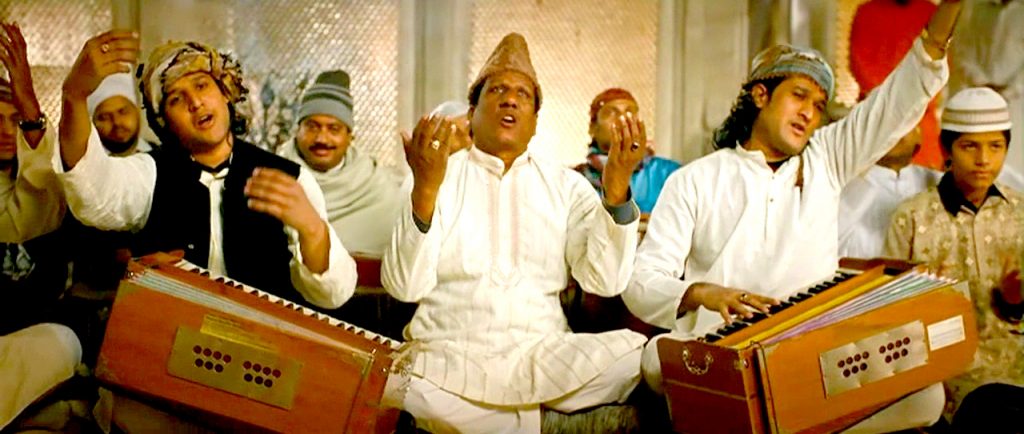
The poetic repertoire in qawwali accommodates a wide array of poetry. There are local variations, but there is also a core corpus of poems familiar to most qawwals and listeners. Strict orders with respect to music in Islam are teleological, or purpose-based rather than being rule-based While some have been persuaded that music in Islam is prohibited altogether, or if nothing else, some sort of instruments are, this unmitigated approach towards the admissibility of music activity in Islam is invalidated by the presence and significance of devotional musical practices, like, Qawwali. It could be said that music is a bit complicated means of communicating qualities, frames of mind and feelings. Through its verses, rhythm, and structure associated with such a presentation, Qawwali music developed as a center practice to push Sufi seekers further into the discovery of divine knowledge. There are two components that characterize Qawwali’s identity, first is the music as a major aspect of an Indo-Islamic culture of sound, and the second is the act, or event, or the performance in a particular setting.
The former element signifies the combination of sounds from singing, instruments, rhythms and applauding that results in the creation of a specific oral culture. The latter element is derived from the Sufi tradition of sama’ (musical concert) which is essentially the context, structure and custom in which devotional music is practiced.
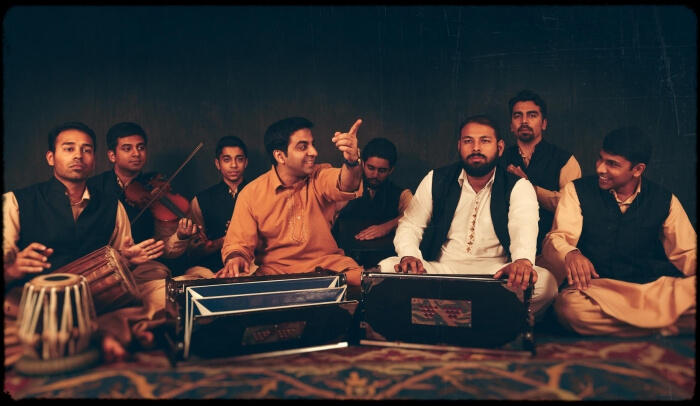
The term Qawwali comes from the Arabic word Qaul, which means articulation, normally from sacred Islamic sources, for example, the Prophet Muhammad’s truisms or mystical verse. A Qawwal is a learned individual who repeats such utterances, filling in as a mode for an audience to build their knowledge through oral transmission or advance their spiritual state. Thus, Qawwali has two functions, one is to go about as a medium to proliferate Islamic lessons, qualities and frames of mind to Muslims and non-Muslims alike. The other is to persuade Sufi seekers on a specific spiritual path with a feeling of elation, serving as a vehicle of spiritual ascension.
Generally, Qawwali is solely a male-dominated activity: the spiritual guide, performers are all male. In spite of the fact that this particularly limited variant of Sufi practice was confined to males, sama’ all in all isn’t. The subgenres of sama’ are generally segregated so as to counteract immoral male-female communication as per Islamic ruling.
Amir Khusraw (1253-1325), a mystic poet and student of the Chishti Sufi School, is considered the founder of Qawwali. Khusraw mixed components from Persian verse, Arabic writings and Hindustani musical styles to make a culturally rich medium for conveying universal Islamic qualities, for example, an affection for God, the Prophet, and other religious personalities. He invented the two instruments that are at the core of Qawwali music, the sitar and the tabla. Qawwali is related to the Indian Subcontinent because of its geographic origin there, but the essence of such a medium is common to international sama’ practices.
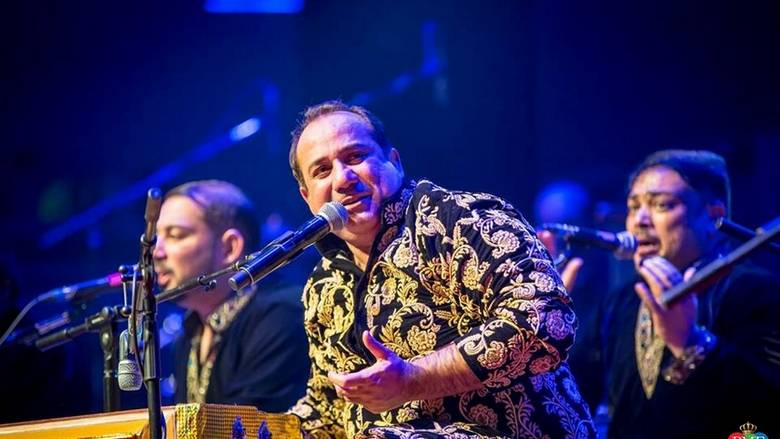
How Bollywood has tailored Qawwali
Qawwali was created with purely sacred intentions, so it is important to contrast its original authentic form with its current, so-called filmy, popularized form. The modern “bollywoodization” of Qawwali music is not adverse, per se, but rather highly contrary to the initial objectives of such a medium of technology. In her essay entitled “Devotion or Pleasure? Music and Meaning in the Celluloid Performances of Qawwali in South Asia and the Diaspora,” Nathali Sarrazin points out the following in reference to the modern morphing of Qawwali “The subject of the lyrics and the object of the singer’s attention are at odds, as the qawwals direct their metaphysical attention to the physical world embodied by lovers.”
Originally, the Qawwali performance was organized in a manner that included a group of singers in a standard seating arrangement playing conventional instruments and moving in a reserved kinaesthetic fashion. In films and concerts, impromptu creation and natural movement are supplanted by over-exaggerated kinaesthetic movement. “Devotion and zeal are repackaged in rock-star like movement.” This occurrence appears to be in stark contrast with the principles of authentic Qawwali.
In films, Qawwali is to a great extent used to emulate and substitute Indian folk music. Thus, Qawwali is no longer essentially performed under the pennant of an Islamic narrative. Rather than being the focal point of the film or other medium, Qawwali is blended in with other eye-and ear-catching mechanisms, such as choreographies and elaborate costumes. Also, Qawwali is utilized as a medium to uphold the narrative of a given story. Such stories frequently include love and desire in the framework of Bollywood: “Songs typically mediate or speak on behalf of a couple, helping them to express their own emotions. The popularisation of Qawwali has experienced identity changes by melding with other musical genres, new innovative instruments as well as including females into the originally male-exclusive medium.
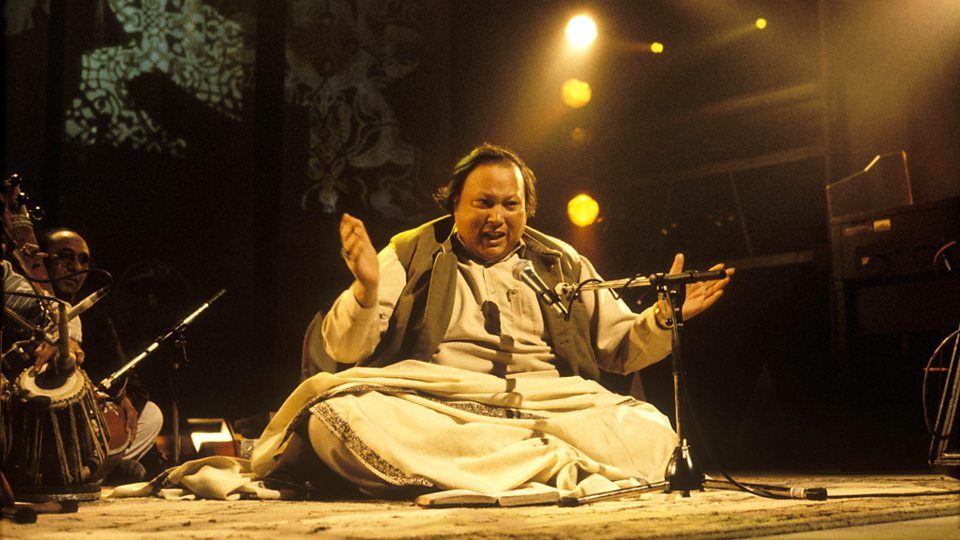
Nusrat Fateh Ali Khan and A.R Rehman are the biggest names when it comes to the new popularised Qawwali. Their music also consists of the same themes of love, but it seems to precisely turn the hearts away from the spiritual to worldly love. What was once utilized as a medium to impel association with the Divine is utilized today to drive union between couples in films. Present-day popularised Qawwali exploits its predecessor’s sacred poems and capacity to induce spiritual happiness to shape it into a reworking of delights and wants. “Undoubtedly, modern “filmy” Qawwali suggests hedonistic fantasies that are astonishingly at odds with the original form of this music form.”
If Qawwali’s role as a medium for spiritual ascension and religious dissemination has shifted so drastically, to what extent is this medium still considered holistically “Qawwali?” Is authentic Qawwali dead? Authentic Qawwali is not dead as the Qawwals at the dargah were singing the modernised version of the Qawwali but the authentic version. The audience was there, a sama was created and one could feel the connection with the almighty. The popularised version has created a different space for itself and it could be said that both the forms can coexist.
SOURCES
1) Bhattacharjee, Anuradha and Shadab Alam, The Origin and Journey of Qawwali: From Sacred Ritual to Entertainment (Journal of Creative Communications, 2012), 34.
2) Abbas, Shemeem Burney, The Female Voice in Sufi Ritual: Devotional Practices of Pakistan and India (University of Texas Press, 2002), 147.
3)Burckhardt Qureshi, Regula, Sufi Music of India and Pakistan: Sound, Context, and Meaning in Qawwali (University of Chicago Press, 1995), 39.
4)Sharma, Sunil. Amir Khusraw: The Poet of Sultans and Sufis (Oneworld Publications, Oxford, 2005), 274.
5)Vajpeyi, Ananya, The Indo-Persian Sublime: From Amir Khusro to Shahzia Sikander (Wasafiri, 24:2, 2009), 37.
6) TALA HAMMOUR, Qawwali as Media from its Traditional to its Modern Form





















